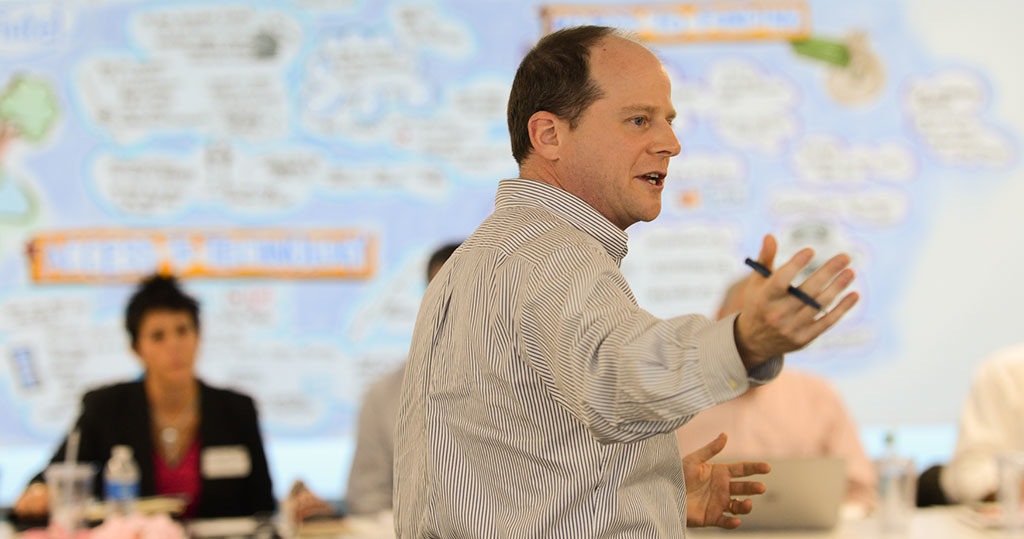Sue Hunt, chief marketing officer for the United States Tennis Association, talks about her focus on youth tennis.
By Giovanna Fabiano
Whether she’s promoting bathroom tissue, beauty products or professional tennis, Sue Hunt brings her A-game to every role she takes on, employing one key rule: Know your audience.

As chief marketing officer for the United States Tennis Association (USTA), she oversees marketing and digital efforts, with a focus on introducing recreational youth tennis to a wider audience.
Before joining the USTA in 2006, Hunt held several marketing and sales positions at Procter & Gamble, Unilever and Kraft.
She recently shared some advice with Real Business about the importance of believing in your brand and not being afraid to be provocative in order to get your message across.
You have an impressive background, working in marketing for a variety of industries. Was it difficult to go from Nabisco and L’Oreal to the USTA? Is sports marketing a totally different ballgame?
I think the reason why I’ve had success in my role in marketing is that I’ve focused primarily on the role itself versus the industry. You can’t be frightened to work in any category, and you have to do your homework and learn what barriers exist, what consumer needs there are, and what gaps there are. When you start a new position, you’re almost like an investigator, so whether you’re working on bathroom tissue, sports, or beauty, you try to bring that same discipline to any category.
You were promoted to CMO in 2011 and tasked with emphasizing youth tennis (Ten and Under). How has your focus shifted and what kinds of challenges come with dealing with kids versus adults on the professional circuit?
I was hired at the USTA in my early days to strictly work on pro tennis and our brand was firmly established. When I was promoted to chief marketing officer, the focus was to really take on recreational tennis, so I took a good three to six months to really analyze the category. It’s a pretty conservative, pretty historic category, and it didn’t have a strong focus on marketing and what the brand was, so it was a great opportunity to grow in a different way. It was a scary task to navigate, given the history, and the fact that the USTA is a not for profit. The thing is, you’ve got to run it like a profit business. I had to take a balanced approached and take the time to learn the category first.
I think the USTA focused on every age group for so long. When I went in and started looking at recreational tennis, there were certain segments we wanted to grow more than others. In the youth segment of the market, a worldwide rule change was implemented where all children under the age of ten were required to play on courts with rackets and balls that were sized right for kids. That set tennis up to compete evenly with youth football, basketball, and baseball, so it was a revolutionary change. There’s been a 13 percent increase in our sport each year for the last few years, as a result of the rule change and our focus on youth. In 2013, if you look at other recreational sports, most are down in this country, because of this epidemic of inactivity.
How did the rule change impact greater participation among kids?
The one thing I can say universally about kids, or all people, is that people love to feel confident whether they’re playing a sport, or doing just about anything.
Before, we were asking kids to play with the same ball as Roger Federer on the same court using the same grip and the same positioning. They weren’t able to do it. Kids weren’t enjoying the game. On the other hand, you put kids on a soccer field for one day, they are out there getting it and having fun. That’s what we want tennis to be like for kids.
ARVE Error: need id and providerWhat are some changes your team implemented to go along with the new rule? Were there specific campaigns aimed at kids and their parents?
Absolutely. The USTA really wanted to bring a discipline to recreational tennis. With this worldwide rule change, they put in place a senior cross-functional team, with an unbelievable focus on youth. We called it the “Youth Imperative,” but made sure that at the same time, we weren’t taking our eye off the ball with adults.
First off, we encouraged tennis pros not to make it boring. We wanted kids to feel really comfortable going out there and giving it a try. Now our tennis pros are more like coaches. We asked ourselves, “Am I targeting a current user or a new user? If I’m really going after a new user, am I being provocative enough?”
One 60-second spot we ran, we had Steffi Graf and Andre Agassi reading an animated storybook. The premise of the story was this: The rackets were too big, the nets were too big, so Sophie quit and took up soccer. The end. But there is a happy ending. Courts, balls and rackets have now been sized right.
By mentioning soccer, you’re literally staring the competition in the eye. So it was scary and nerve-wracking, but I wanted to be provocative enough to really make a difference.
Another spot we did was to take 8-year-old kids and put them on full-sized basketball courts and asked them to play the sport.. It said, “Other sports are sized right. Why isn’t tennis? We’ve now changed it.” For a traditional sport like tennis, you have to wake up the category and have people look at the sport differently.
How important is it to get the right spokespeople for these types of ads?
Super important — for not just kids, but their parents as well. Let me give you an example. Michelle Obama wanted to be in our television spot, “Let’s Move,” so immediately, our agency went to work. Why don’t we put a couple kids between 8 and 10 on the court … kids who play with the smaller equipment? Why don’t we give them a ball person? Michelle Obama agreed to be a ball girl and she just nailed it.
In today’s environment, parents are looking for trusted role models. When it comes to sending a message about getting your kids active, the effect this is going to have on kids and their ability to succeed, you need spokespeople who are very strong. Michelle Obama came to Arthur Ashe kids day, and the security around it and the planning that went into it was intense. But to have the First Lady stand up, it was just critical.
Some of my coworkers wondered if it was worth all of the security checks. It was.
Sue Hunt was a speaker at Xerox’s simple@work conference. She was among several world-renowned speakers and experts, including Jay Baer and Anders Sorman-Nilsson, who shared advice on turning your business processes into real advantages.
Register for virtual simple@work, and get access to a selection of insightful presentations from the live event we sponsored earlier in March. Our virtual event allows you to view these presentations at a time and place that is convenient for you.



